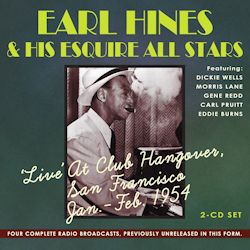CD1
1. Deep Forest
2. Sleepwalkin’
3. Love Is Just Around The Corner
4. Ain’t Misbehavin’
5. Tin Roof Blues
6. Do You Know What It Means To Miss New Orleans
7. Deep Forest
9. St. Louis Blues
10. Basin Street Blues
11. Flying Home
12. Sweet Lorraine
13. Joy Jump
14. Medley: One O’Clock Jump/Deep Forest
CD2
1. Deep Forest
2. Hot Soup
3. St. James Infirmary Blues
4. I Know That You Know
5. I’m Afraid To Love You
6. Undecided
7. Piano Man
8. Deep Forest
9. Take The “A” Train
10. Ballin’ The Jack
11. You’re The Cream In My Coffee
12. I Can’t Get Started With You
13. Bugle Blues
14. Rosetta
15. Deep Forest
Earl Hines - Piano, vocals
Dickie Wells - Trombone
Morris Lane - Tenor sax
Gene Redd - Trumpet, tenor sax, vibes
Carl Pruitt - Bass
Eddie Burns - Drums
In the history of jazz, there are really very few originals, but one of the most influential was Earl Hines. He was a stylistic innovator and he taught
piano players that they could break free from the usual conventional rhythmic and melodic customs, and make the piano part of unrehearsed composing. In The Oxford Companion To Jazz edited by Bill Kirchner, in a piece written by Henry Martin entitled “Pianists of the 1920s and 1930s”, he says about
Earl Hines: “the most important pianist in the transition from stride to swing was Earl ‘Fatha’ Hines.” These direct over-the-air broadcast recordings are
a wonderful representation of that exceptional musician.
CD1
While these over-the-air broadcasts directly from the clubs brought with them a certain intimacy and spontaneity, they were ofttimes encumbered with less
than adequate sound, rickety pianos, and announcers who took over the broadcasts with drivel. These are some of the perils of this offering, but once past
that, the music was a combination of first-rate swing and Dixieland that Hines used to demonstrate his unquestioned talent. Working with a band that
included the inimitable trombonist Dickie Wells (who had been in the Basie band from 1938 to 1950), the group played with enthusiasm that was reflective of
their surroundings. After a quick rundown of the theme Deep Forest, the band swings into a Hines original entitled Sleepwalkin’ which is an up-tempo rouser with Dickie Wells taking a long and strong solo and then Morris Lane offering a solo on tenor which generates much
crowd appreciation. Love Is Just Around The Corner follows, and is all Hines as he takes the piano apart with his command of the keyboard. Another
Hines standout is his boogie-woogie version of St. Louis Blues where his left-hand literally holds the beat and the right flies over the keys.
While he was never thought of as a vocalist, Hines developed a rather unique style that in many ways mimicked his piano technique. With a light tenor
voice, Hines gives a run-through of Do You Know What It Means To Miss New Orleans? that is quite evocative of that great southern city. Not
wishing to neglect the swing side of the band, the Benny Goodman-Lionel Hampton tune Flying Home is a star turn for Gene Redd on vibraphone and
the Count Basie flag waver One O’Clock Jump closes out the set in fine form with all the band members strutting their stuff.
CD2
In 1954 when these broadcasts originated, it was not unusual for jazz bands to take up residence at clubs for extended periods. So for Hines and the band
to be at Club Hangover for a month was in keeping with the times. Today, of course, club economics simply do not allow for such a practice especially as
announcer Bob Guerner likes to state that the club has a policy of no admission charge, no cover, and no minimum. Oh, for the good old days. One of the
advantages of these long-stay arrangements was that the band accustomed themselves to the club environment, built up a solid following of patrons, and
settled into a groove with their playing. Additionally since these were not recording sessions but radio broadcasts, the set selections tended to be
lengthy and more showy to entertain the club patrons. For example, St. James Infirmary Blues is done with a Latin flair as Hines adds a pithy
vocal interpretation to the lyrics. Tenor saxophonist Morris Lane started recording in the mid 1940s and was an early convert to bebop in a group called
the Bebop Boys which was led by Sonny Stitt. Although he never gained much individual recognition, he had a strong swinging style which comes to the fore
on Undecided. Billy Strayhorn’s Take The “A” Train is offered as a mid-tempo swinger as
Hines piano takes the lead with unusual runs and then each member of the band chips in with solos of varying length. All the while Hines offers vocal
exhortations. One of Hines’ best-known compositions Rosetta closes out the session with Hines demonstrating is no uncertain terms that he was a
pianist to be reckoned with.
An interesting session of previously unavailable material from an Earl Hines band that did not remain together much longer.
Pierre Giroux
